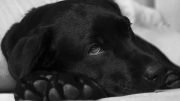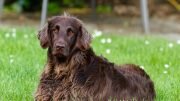The Norwegian Buhund is a Norwegian sheepdog of a spitz-type breed. Traditionally, it was kept for guarding farms or herding including flocks of sheep, droves of cattle, small livestock, reindeer, and pigs. Occasionally, it was used for hunting elks, bears, and wolves. Its name is a derivative of “bustadshund,” from the old Norwegian term “bu,” meaning “homestead.”
The Norwegian Buhund is considered to be directly descended from the dogs of early settlers of Norway, since remains of spitz canines were found at the oldest archeological sites, according to the genetics resource center documentation from the Norwegian Kennel Club (NKK).
Its origins are believed to go back more than a thousand years, and the breed has allegedly existed prior to the Viking Age.
The first account of the Norwegian Buhund was by the Icelandic historian Snorre Sturlason in Kongesogur. The group of Buhund mentioned in that account somewhat differs from the contemporary Buhund, but it is considered its ancestor nonetheless.
At the beginning of the 1900s, a sudden decline of the Norwegian Buhund population occurred due to the competition from popular new breeds imported to the country.
A history of coordinated efforts
Around the late 1920s, efforts to ensure the breed’s future and importance began.
In 1925, the first Buhund show was instituted. In 1926, its breed standard and the pedigree book for the Buhund was published.
That same year, the dogs were presented for the first time in a show hosted by the Norwegian Kennel Club, receiving huge recognition.
Soon after the show, organized efforts to promote the Buhund as a breed started.
The Norsk Buhundklubb was established in 1939. It was one of the largest breed associations in Norway even after the war. There were 135 dogs at the national show in 1945.
However, around the 1950s, fewer Norwegian Buhund were being presented, resulting in less presence of the breed all over the country.
The Norwegian Kennel Club restored the breed’s popularity through systematic registration, controlled breeding, and exhibits.
However, the Norwegian Buhund is still small in number and the Buhund association strives to safeguard the breed.
An estimated 1,000 dogs live in Norway, and 700-800 live in Denmark and Sweden.
The Norwegian Kennel Club has registered approximately 100-150 Norwegian Buhund puppies annually over the last years and has aimed to improve the population in order to maintain sound and effective breeding efforts.
The Norwegian Buhund
According to the descriptions by the American Kennel Club and the Swedish Kennel Club, the Norwegian Buhund is “a watchdog, farmdog, and herder of polyvalent use.”
It is slightly smaller than medium size and square in profile. Males stand at 43-47 cm and weigh 14-18 kg, while females stand at 41-45 cm and weigh 26 to 12-16 kg.
Male Buhunds are said to be more affectionate and glad to accompany their owners than female Buhunds, but females are less stubborn than males and acknowledge reprimands better, according to the UK Buhund Club.
The Norwegian Buhund Club claims that the dogs are commonly known to suffer from hereditary genetic cataracts and Pulverulent Nuclear or Buhundkatarakt which affects more than 50% of the breed.
In addition, the European College of Veterinary Ophthalmologists states that the dogs suffer from posterior polar cortica and retinal dysplasia. The American Kennel Club asserts that conditions such as von Willebrand’s disease, hip dysplasia, and obesity may also occur if handled irresponsibly.
As a nordic spitz archetype, these dogs are characterized by their wedge-shaped head, pricked pointy ears, tails firmly rolled over the back, and a rich double-coat resilient to harsh winter.
There are two colors of the Norwegian Buhund: the wheaten or biscuit-colored Buhunds have shades of pale cream to bright orange, either with or without dark-tipped fur; and the black Buhunds, which sometimes have a little bit of bronzing and white blaze on the chest or collar.
Lifespan
They have a lifespan of over 12 years. They are fun-loving, good-natured family dogs, and do get along well with children. However, they are inclined to bark.
They don’t do well on very warm days. They naturally clean themselves and don’t require trimming.
They require brushing or combing at least twice a week, and vigorous and stimulating exercises twice a day are indispensable – retrieving balls, long hikes, and the like.
The Buhunds are full of energy, clever, versatile, and have exceptional learning abilities and potential.
They are quick to learn, willing to please, and much easier to train in comparison to other northern spitz variants.
Moreover, their strong independent tendencies can get the better of their focus to continue training, but they are particularly food-motivated.
Therefore, persistence, positive methods, clicker training, and food luring are effective.
A large number of these dogs are obedient and agile, especially in tracking or searching activities. In the UK, they are used as guide dogs and drug detection dogs.
Source: Norway Today / #NorwayTodayTravel




Be the first to comment on "The Norwegian Buhund: Norway’s clever and agile shepherd dog"